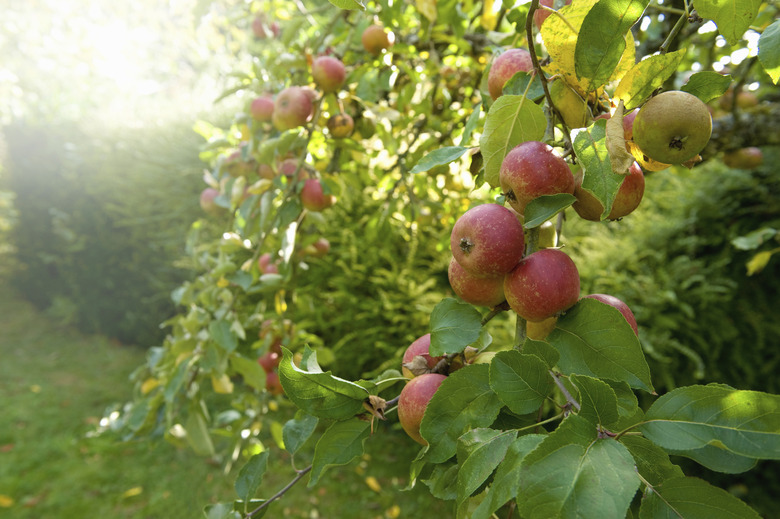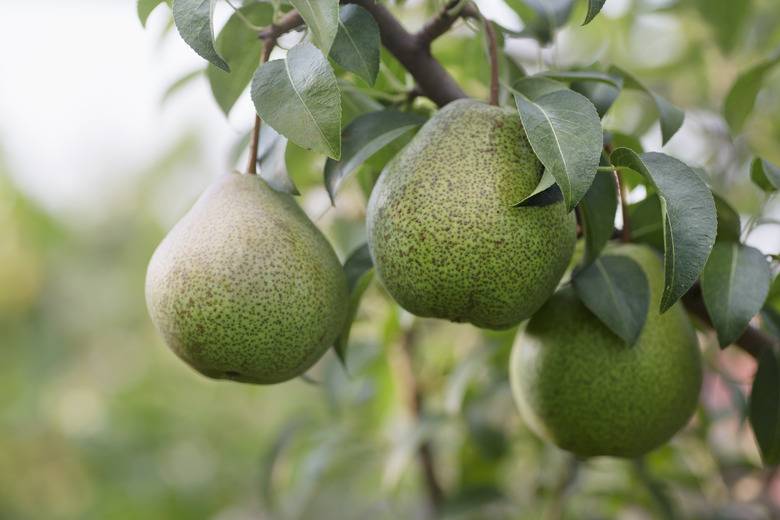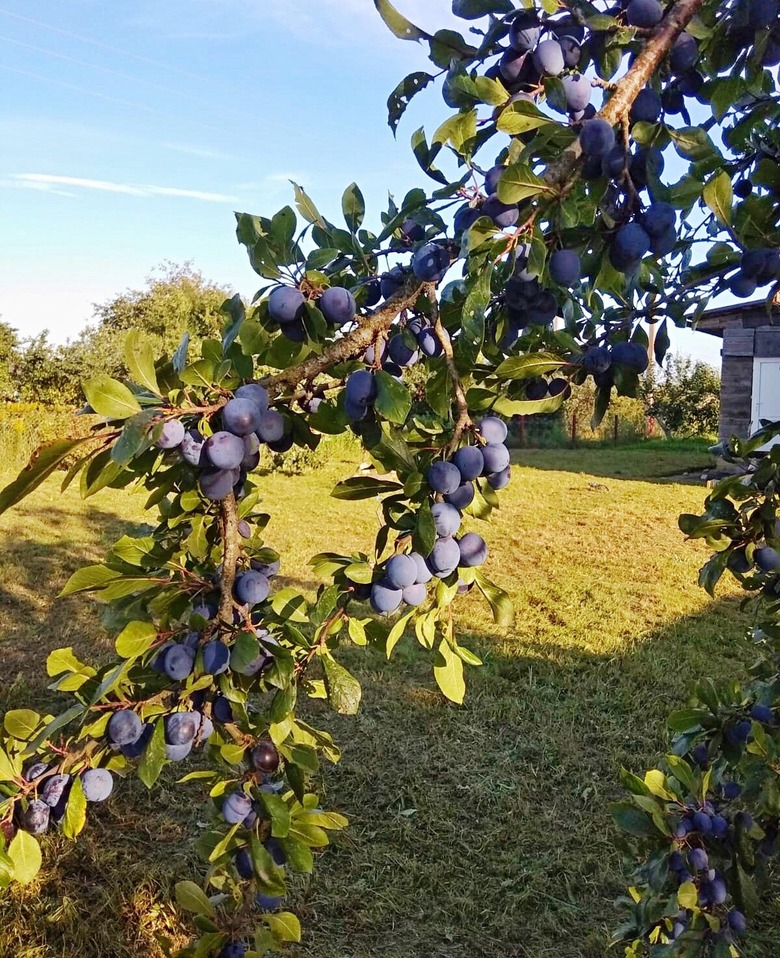The 5 Easiest Fruit Trees To Grow
We may receive a commission on purchases made from links.
If you're just starting your gardening career and you want to get a few fruit trees established quickly, you don't have to search for exotic varieties because most of the fruits you eat every day grow quickly with a minimum of effort on your part. This includes pears, peaches and figs for people living in temperate growing zones, citrus for people in the South and apples and cherries for those in more northern zones.
Growing Fruit Trees at Home
Growing Fruit Trees at Home
The main reason you might want to grow fruit trees is to get delicious fruit, but there are plenty of other reasons. Fruit trees provide shade, beautiful spring blossoms and habitats for the birds and bees. Some varieties of fruit trees are hardy almost anywhere, but to produce great fruit, all need a characteristic number of chill hours, which is the cumulative number of hours per year with temperatures between 32 and 45 degrees Fahrenheit. Chill hours aren't the same as USDA hardiness zones, but they're related, and the growing zone is usually all the information you need.
Fruit trees go dormant in cold weather, and if they emerge too soon from dormancy because of too few chill hours, they won't fruit, or the fruit will be undersized. If they emerge too late, pollination is adversely affected. You can find the number of chill hours your region receives from your local gardening center or cooperative extension service so you can choose suitable varieties to grow.
Tip
You can also grow dwarf fruit trees in containers on the patio, greenhouse or sunroom. Most fruiting trees are available as semi-dwarf or dwarf cultivars, though a few, such as the Meyer lemon (Citrus x meyeri 'Improved Meyer,' USDA zones 9 to 11), are naturally small trees. Plant in 5 gallon pots and move up to 24-inch-wide and equally deep containers as the tree grows. Provide plenty of light, water, fertilizer and be sure to prune to maintain the shape and size of container-grown trees.
Fruit tree varieties tend to be region-specific, but a general list of the easiest fruit trees to grow in a home orchard would include these five trees. Most are available as space-saving semi-dwarf cultivars, allowing for two or more trees in the average backyard.
1. Apple Trees and Home Orchards
1. Apple Trees and Home Orchards
While apple trees (Malus domestica) require more chill hours than most other fruits, and although there are long-season cultivars that produce great fruit as far south as zone 9, most hardy varieties do best in zones 3 through 5 and mostly in the northern and western parts of the country, where fungal diseases are less rampant. You almost always find apple trees in orchards because more than one tree is needed for cross-pollination, which ensures the production of fruit. To get the best fruit, it takes two different cultivars that flower at the same time and plenty of bees to carry the pollen.
Apple trees tend to grow broad rather than tall, and they produce fragrant white or pink blossoms in the early spring, followed by fruit that is ready for harvest in the fall. There are many cultivars with chill requirements varying from 300 to 1,200 hours, and they prefer full sun and plenty of moisture. To get the best fruit from an apple tree, you should prune it periodically to thin the branches and make room for the fruit, and the best time to do this is when the tree is dormant.
2. Pear Trees: European and Asian
2. Pear Trees: European and Asian
Pear trees (Pyris communis) are another cold-weather fruit tree, and they are even easier to grow than apple trees. They grow in USDA zones 4 to 8, although some varieties can tolerate the cold winters in zone 3. European varieties, such as Bosc, Anjou and Bartlett, produce the classic pear-shaped fruit, while the fruit from Asian varieties, such as Hosui, Chojuro and Shinseiki, tends to be round like an apple. European varieties need between 600 and 900 chill hours for fruit production, while the Asian varieties need only 300 to 600 hours.
The size of a pear tree is primarily dependent on the rootstock. A tree growing from a standard rootstock can reach a height of 30 feet with a spread of 20 feet, but dwarf varieties growing from dwarf rootstocks may only grow to 8 feet tall and wide. Pears bloom earlier in the spring than apples, producing delicate white blossoms, and the fruit is ready for harvest from late summer to late fall depending on the cultivar. Only a few pear cultivars are self-fertile; most need pollen from a different cultivar that blooms at the same time and the services of a pollinator, such as bees or hummingbirds.
3. Cherry Trees: Sweet and Sour
3. Cherry Trees: Sweet and Sour
Although the cherry trees that produce the iconic blossoms for which Japan is so well known do not produce edible fruit, several fruiting species produce blossoms that are just as striking. You can choose sweet cherries (Prunus avium) for snacking if you live in USDA zone 5 to 7 or sour cherries (Prunus cerasus) for baking if you're in zone 4 through 8. Most cherry tree varieties are self-fertile, but fruit will be bigger, tastier, and more prolific if there's a different cherry cultivar growing nearby.
Cherries are a type of stone fruit, and the difference between sweet ones and sour ones is the amount of citric acid they contain. Standard-size sweet cherry trees can reach heights of 35 feet, while dwarf cultivars grow to about 15 feet. Wood obtained from full-size cherry trees is a prized material for making cabinets and interior woodwork.
4. Plum Trees: European, American and Japanese
4. Plum Trees: European, American and Japanese
Like some apple and pear varieties, plum trees (Prunus spp.) will grow as far north as zone 3 and as far south as zone 7, with most varieties fruiting with as few as 300 chill hours. European varieties, which grow in most of the country, are self-fertile, while the hardier American varieties typically need cross-pollination to bear fruit. Japanese plum varieties, which also need to cross-pollinate to produce fruit, are more susceptible to spring frosts and are better suited for zones 5 to 7 than the more northern zones.
Plum trees need well-draining soil and full sun and won't do well in clay soil that retains moisture. Plum trees can grow from 20 to 30 feet high, and they produce blossoms that are almost as attractive and iconic as cherry blossoms, with white, pink and even deep-red coloration that takes over the tree for a two-week period in March or April. Plums are ready to harvest when they soften and turn deep red to purple, which occurs from mid-July through September.
5. Figs: A Warm Climate Favorite
5. Figs: A Warm Climate Favorite
The fig tree (Ficus carica) doesn't grow as far north as many other fruit trees, with most types being hardy only to zone 7 (although some cold-hardy cultivars like 'Chicago Hardy' may grow to zone 5 when provided winter protection). These fruit trees need only 100 chill hours to produce tasty fruit. The tree, which reaches a height of 15 to 30 feet and can also grow as a shrub, likes to be in full sun and prefers well-draining soil, although in arid regions, it's a good idea to mulch to help the soil retain moisture.
The edible fig tree is low maintenance and is one of the easiest fruit tree species to grow because it is highly resistant to pests and diseases and will self-pollinate. Some types of fig trees have specific pollination requirements, such as the ones that need to be pollinated by specific species of fig wasp. This makes them too much trouble for the average grower, which is why commercial fig growers typically grow these types.
Fig trees aren't known for their flowers, and that's because the flowers are hidden inside the fruit. They are known, however, for their oversized leaves, which have many references in religious lore, and for their delicious fruit. The edible fig tree produces greenish fruit that turns purple as it ripens, and it's ready for harvest when it turns soft and the purple color predominates, which generally happens from midsummer to midfall. It's important to wait for figs to soften before you pick them because unlike some fruits, they won't ripen after picking, and unripe figs are practically inedible.


